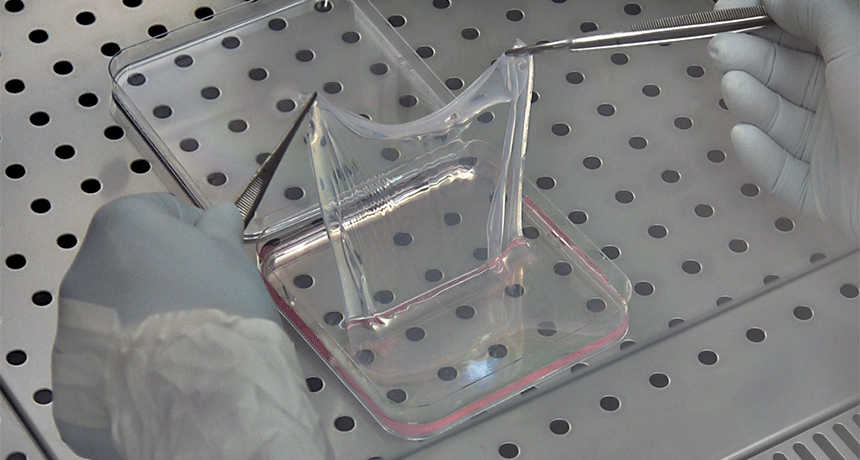Doctors repair skin of boy dying from ‘butterfly’ disease
Scientists had to replace 80 percent of his skin

This is a section of lab-grown skin. Such skin was used to treat a boy with “butterfly” disease.
CMR Unimore
In a last-ditch effort to save a dying 7-year-old boy, scientists have used stem cells and gene therapy to replace about 80 percent of his skin. The effort showed that this combination therapy may be effective against some rare genetic skin disorders.
The case is a landmark in stem-cell therapy, says Elaine Fuchs. She is a stem-cell researcher at Rockefeller University in New York City and not involved in the boy’s treatment. His case also may settle questions about how the skin renews itself, she adds.
Researchers described how they helped the boy in the November 16 issue of Nature
The child has a rare genetic skin condition. Its name is a mouthful — junctional epidermolysis bullosa (JUNK-shun-ul Eh-pih-der-MAH-le-sis Bu-LO-suh). It’s caused by alterations, known as mutations, in one of three genes: LAMA3, LAMB3 or LAMC2. Those genes produce parts of a protein known as laminin-332. It helps attach the top layer of skin, the epidermis (Ep-ih-DER-mis), to deeper layers. Certain gene mutations can prevent the protein from holding these layers together.
People with the disease are sometimes called “butterfly children.” Why? Their skin is as fragile as the insect’s wings. Even mild friction or bumps can cause severe blistering. That blistering also can affect mucus membranes inside the body. That can make make it hard to breathe, swallow and digest food. About 1 in every 20,000 babies in the United States are born with the condition. That’s roughly 200 children there each year. More than 40 percent die before becoming teenagers.
Fixing a gene
The recently treated boy has a mutation in the LAMB3 gene. When he got a severe skin infection in 2015, most of his skin blistered and fell off. Doctors thought he would die, notes Tobias Hirsch. He’s a plastic surgeon at Ruhr University Bochum in Germany who helped care for the boy. Surgeons in a burn unit tried grafting some of his father’s skin onto the boy. But the child’s body rejected this transplant. (That means his immune system attacked it as a “foreign” substance.)
At that point, Hirsch recalls, “We didn’t have any options to treat this child.”
For help, Hirsch’s team turned to Michele De Luca. She is a stem-cell scientist at the University of Modena and Reggio Emilia in Italy. Hirsch’s group had found tricks for fixing the same genetic defect. They had grown small patches of gene-repaired skin for children who had the same condition.
Together, the tissue needed to treat those cases had totaled some 600 square centimeters (93 square inches). That’s about the size of a piece of letter-size paper. The boy needed far more than that. He had lost nearly all the skin on his back and legs. Other areas had blistered. In all, the researchers needed to replace some 8,500 square centimeters of his skin — or 14 times more than they had produced for the earlier trials.
In September 2015, the team took a 4-square-centimeter (0.6-square-inch) patch of unblistered skin from the boy’s groin. From this, the scientists grew skin stem cells in the lab. (Stem cells are flexible “mother” cells. They divide and make more of themselves and other cells that will become the final types of cells that make up the body. In this case, skin stem cells could become any of many types of skin cells.) Now De Luca’s team inserted a healthy copy of the LAMB3 gene into the DNA of the lab-grown stem cells. To insert the gene, they used a retrovirus. This procedure is known as gene therapy.
This corrected the mutation in the skin stem cells. Those cells now grew into sheets of skin that doctors grafted onto the boy’s body in two surgeries in late 2015. After yet one more surgery to replace small patches of skin, doctors sent the boy home from the hospital in February 2016.
“The kid is now back to school. He plays soccer,” says Hirsch. His new skin is fully functional. He still has some blistering in untreated areas. So his doctors are considering replacing still more skin. Meanwhile, some of the repaired stem cells may be making their way into the boy’s untreated skin. One day, they may replace it. But researchers can’t take many samples of his skin to find out. “He’s a patient,” explains De Luca. “He’s not a mouse.”
Lessons about everyone’s skin
The boy’s case may be important in understanding how skin grows. Skin constantly replaces itself. New skin cells are made from stem cells at the bottom of the epidermis. Those new skin cells slowly travel up to the top and flake away about one month later.
Scientists weren’t sure if lots of different stem cells produced the new skin, or if only a few stem cells made all of it. The gene therapy experiment may help answer that, Fuchs says.
When researchers inserted a healthy gene into the boy’s skin cells, the gene landed in different places in the DNA of each cell. The scientists could keep track of which stem cell produced a patch of skin by seeing where the new gene sits within it. It works sort of like a bar code.
At first, the boy’s skin was a patchwork of cells carrying many different bar codes. But as months passed, just a few bar codes took over. That indicates that only a few stem cells are responsible for making the skin. The other bar codes disappeared because those skin cells had died and flaked away.
It is important for scientists to know this so they can help other people with skin problems. The finding suggests scientists need to be careful to grow the skin-replacing stem cells in the lab, De Luca says.







